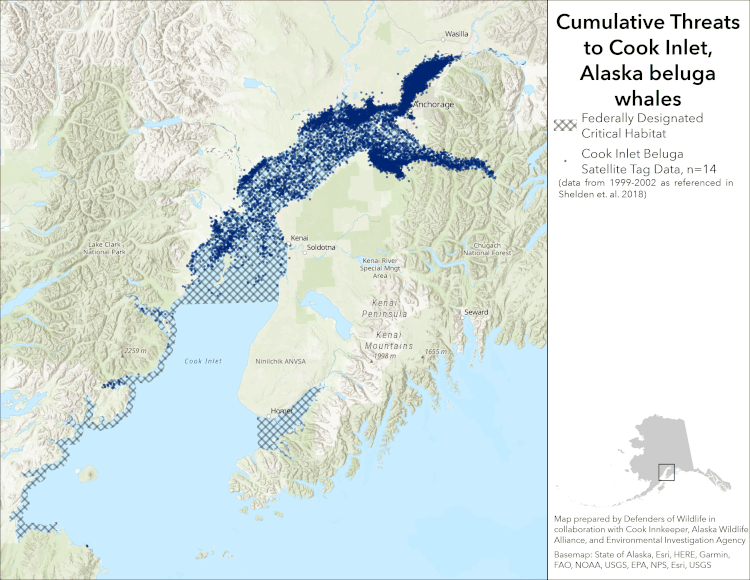Cook Inlet (CI) beluga whales are a unique subspecies. Their geographical location and their history with the Dena’ina are two of the many reasons.
The Aleutian chain essentially traps them in the Cook Inlet, and as a subspecies, they are unique in the fact that they have fewer offspring and live shorter lives compared to others
These whales are also crucial to the Dena’ina, as they used to be hunted for subsistence. With their decline, it is also the death of cultural practice that an entire generation has not been able to experience since 2005.
There are stories of a time when you could go to Cook Inlet and see thousands of Beluga Whales. So many whales, that you could feasibly walk across their backs without falling into the water. In the first survey of Cook Inlet Belugas in 1970, there were roughly around 1,000 whales.
Four decades later, you would be lucky to see seven whales at a time. According to the marine mammal commission, the population stands at around two hundred and eighty as of 2018.
The oldest Cook Inlet whale scientists have found is around 50 years old, which can be dated by their teeth patterns- similar to how you would date a tree by the rings it has in the center.
Mandy Migura founded the Broad Conservation LCC, which works with non-profits like Defenders of Wildlife, Broad Conservation, the Environmental Investigation Agency, and the Alaska Wildlife Alliance. They want to learn more about Cook Inlet Beluga Whales' stressors. She said “We’ve lost over a thousand belugas in this population… That’s a huge, significant loss.”
Her work focused on pinpointing why this might be happening to belugas. Migura says their decline in the past four decades can be attributed to several things that can be categorized as point and non-point pollutants.
Point source polluters have a permit, and pollution comes from a known source. She said, “That would be things such as wastewater treatment facilities, stormwater drains, seafood discharges.”
Non-point-source polluters don’t have a single point of the entrance like point-source polluters. She said, “Examples of that would be runoff from roads or on the airport or when it rains or when the snow melts, that all just kind of runs into the inlet.”
When it comes to point source polluters, Migura’s work focuses on pinpointing the mixing zones, gas and oil activity, and more. Migura and their team created a map that documents maritime shipping patterns, zones where permitted activities could incidentally take beluga whales, mixing zones where pollution is permitted to exceed water quality standards, and oil and gas pipelines and platforms.

Major mixing zones are right on top of locations where Cook Inlet whales are known to congregate more in groups according to the graphic above.
Mixing zones are essentially approved points of pollution.
The State of Alaska’s Department of Environmental Conservation gives out these permits.
A big question that the non-profits have about the mixing zones is how large they are. As of 2023, there is no way of determining how large the mixing zones are in one place. Instead, someone has to open up these permits individually.
Migura says that in order to get a more comprehensive view of the populations' dangers, there needs to be a database that shows all of the mixing zones and how large they are.
The placements of the mixing zones are determined by the organization requesting the mixing zone. The organization also conducts its presentation of risk to wildlife and presents it to the DEC, who then conducts its study on the potential mixing zone and its pollution.
There are no studies conducted by the DEC that take into account all of the active mixing zones and their collective effect on the Cook Inlet.
The general public can get involved by participating in the Alaska beluga monitoring program where citizens can take a class to survey the whales.
That information is used by federal agencies to make policies regarding the Cook Inlet.
Video Taken from Youtube, created by NOAA.


